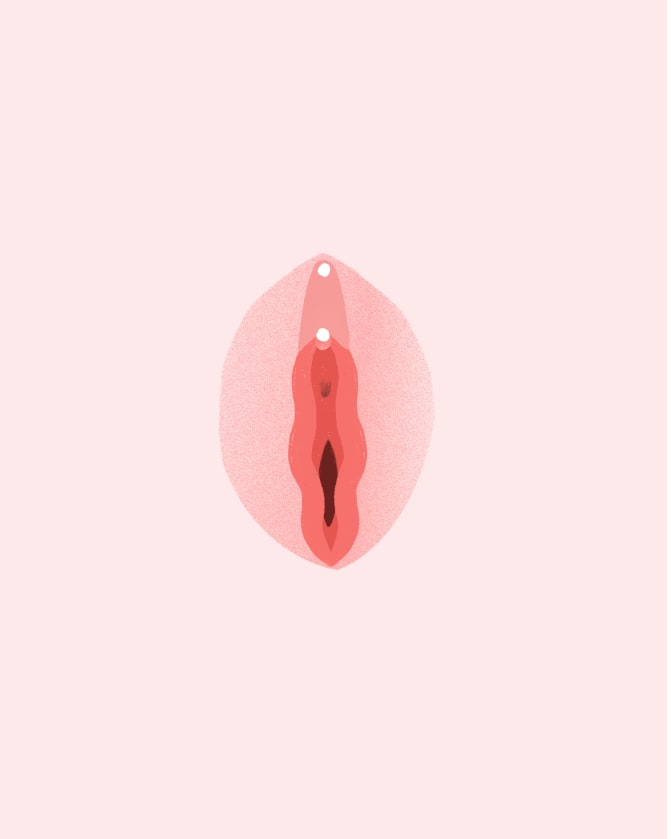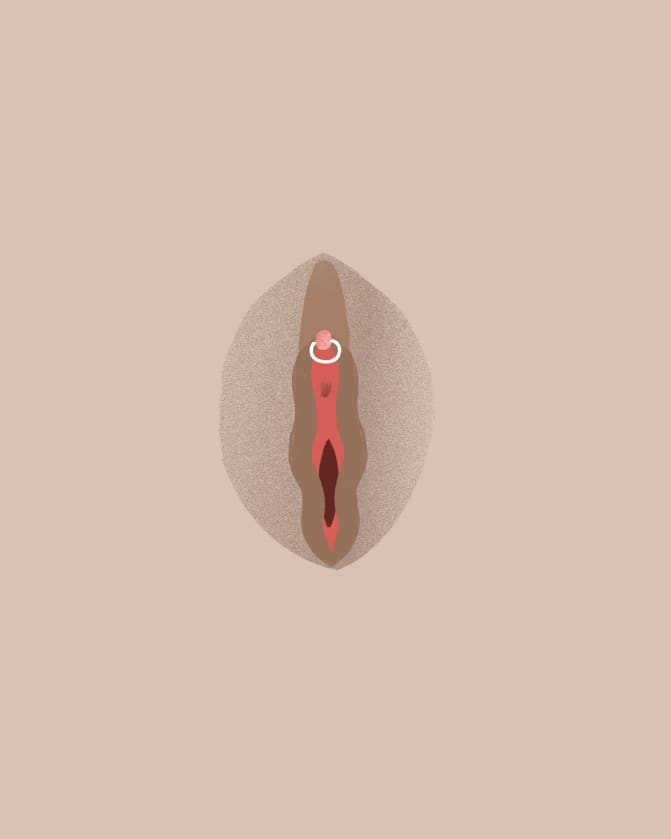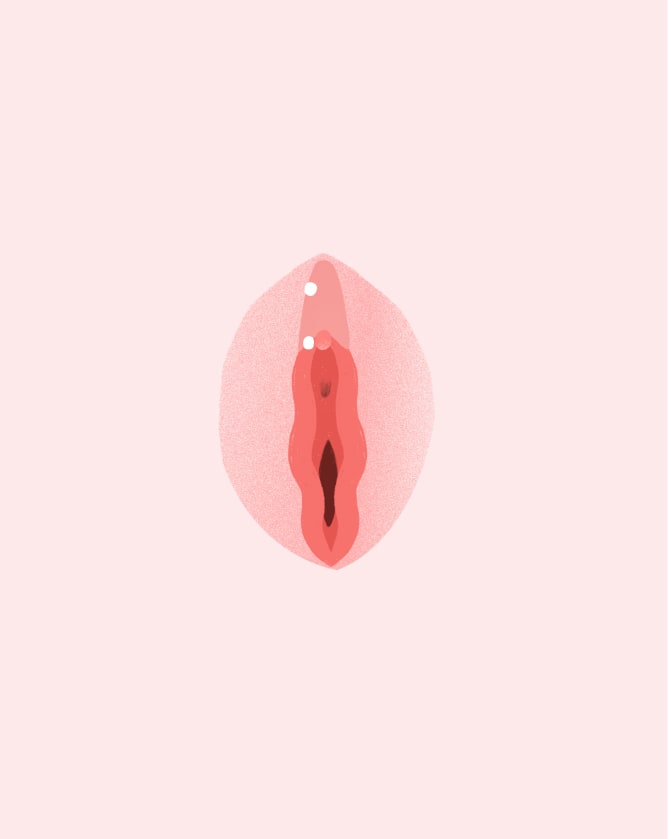Clit piercings, like other vaginal piercings, might seem strange to you at first, but they are much more common than you might think. As many as 2% of women have genital piercings, according to one study. Several reasons motivate people to get this type of piercing, such as improving their appearance and increasing their sexual pleasure. What are the health risks of clit piercings, and can they improve sex life? The following information will help you if you’re considering getting a clit piercing.
The term “clit piercing” is somewhat misleading. The clitoris is a mostly internal sex organ that is responsible for most of the sexual pleasure and orgasm experienced by vulva owners. The clitoris only has one external part, the clitoral glans, the small nub at the top of the vulva. Usually, when someone gets a “clit piercing”, they are actually piercing the clitoral hood, which partially covers the external clitoris.
Here are some types of clit piercings that you can know and get inspired by!
Contents (Click to Jump)
VCH Piercing (Vertical Hood Piercing)
Among all clit piercings, this one is the most popular. This type of jewelry typically consists of a curved barbell. With the lower bead resting against the clitoral glans, the barbell stretches vertically over the clitoris under the hood. Because the jewelry is mostly under the clitoral hood, it can sit comfortably between the legs without irritating the skin. A clitoris may also be stimulated during sex by this drug.
However, 10 to 20% of vulva owners do not have clitoral hoods that are suitable for this type of piercing. The build of some women is simply too small or shallow to get jewelry far enough away from the edge of the hood for safety and stability. There are some people with too large or heavy pubic mounds, which can interfere with jewelry and cause irritation or even embedding.
Check out a similar piercing here.
HCH Piercing (Horizontal Hood Piercing)
On this one, a horizontal hoop of jewelry runs from top to bottom of the clitoral hood. The clitoral glans of vulva owners will not enhance their sexual pleasure unless they are somewhat exposed and unless the jewelry is properly sized and positioned, and even fewer vulva owners will be suited to the vertical hood piercing. Concave or flat builds can have convex hoods, but not concave or flat builds. Also, the pattern needs to be relatively symmetrical, and many women have asymmetrical patterns in this region. In addition, some women have veins that interfere with placement.
Check out a similar piercing here.
Triangle Piercing
The triangle piercing is located at the bottom of the clitoral hood, so the jewelry lies below the clitoral shaft. Vulva owners will be less likely to wear this one, but those who do sometimes report enhanced sexual pleasure since the jewelry stimulates the clitoral shaft from behind. After getting one of these piercings, I’ve had clients who hadn’t ever experienced an orgasm before experiencing them.
Check out a similar piercing here.
Clitoral Glans Piercing
In this clit piercing, the clitoris is pierced directly through the glans; it is the only clit piercing that goes through the clitoris itself. One of the least common types of clit piercing is the glans piercing, since the glans have more nerve endings than the hood, and most clitorises are either too small or heavily hooded for this type of piercing.
Check out a similar piercing here.
The Princess Diana Piercing
It is sometimes called the Duke’s piercing (usually by people with clits who don’t identify as females), and is similar to the VCH piercing, but rather than being located in the middle of the clitoral hood, it is located on one or both sides. In the event the clitoral hood is full enough, the VCH piercing can also be done in a 3-piece combo with one in the middle and one on each side.
Check out a similar piercing here.
Christina
Christina, also called Venus, is not actually a clitoral glans or hood piercing – however, it’s often recommended as an alternative. There is one point of insertion through the very front of the vulva, called the Venus cleft. After it emerges from the mons pubis, it extends through a small section of the mons pubis.
Other kinds of vulva piercings
People who have vulvas that extend to the inner and outer labia, urethra, mons pubis, and frenulum have many options for genital piercings. There are two common reasons for labia piercings – aesthetic reasons and the fact that you can add a ring (or several) to this part of your body without much-added sensation.
As the Princess Albertina piercing goes through the urethra and exits at the bottom, it does not interact with other genital piercings as it rests between the inner labia. Due to the fact that it provides pleasurable stimulation to the urethra, this piercing has grown in popularity. Many people find that piercing is pleasurable and can add pleasure to their lives if they are able to place the Fourchette Piercing between the vagina and anus. Finally, there’s the Christina piercing, which does not necessarily represent a genital piercing, as it is located atop the mons pubis, but exits at the top of the vulva. This piercing is considered to be a surface piercing since it is done for aesthetic purposes.
What is the Procedure for Genital Piercing?
It is always recommended that you have a genital piercing performed by a licensed professional. Some states do not require piercers to be licensed, which means that a person with little training could open a piercing salon without a license. When searching for a professional, you’ll want to look for a certificate that indicates they are registered with the Association of Professional Piercers (APP) — an organization that makes safety rules for piercers. For an individual to be registered in the APP, compliance with the standards of the organization must be demonstrated.
Piercers clean the skin before piercing it and then mark the area where the piercing should be located. As the needle with the attached piece of jewelry is threaded through the skin, the piercer will close the wound. You should receive instructions on how to care for the piercing from the piercer after the procedure is finished.
Approximately a quarter of vulva owners orgasm when they share clitoral stimulation, which is why they do not orgasm routinely through intercourse. Nevertheless, some people with vertical and horizontal clitoral hood piercings claim that the movement of the jewelry during intercourse stimulates the clitoral area. It is more likely that the triangle piercing will produce pleasure through the grinding motions involved. Numerous clients have experienced an increase in sexual responsiveness and orgasmic ability after hood piercings
In spite of this, some of his clients have reported increased sexual pleasure, but most do not. This is more of an aesthetic issue.
Piercings on the clericoral glans and hood can boost arousal and pleasure whether you are playing, or you are sexually active with a partner – and even when you aren’t feisty.
For your benefit
The VCH, Princess Diana, or triangle piercings are the most likely to increase sensation for the piercing wearer.
A bead is typically used in the VCH and Princess Diana piercings to rest on and stimulate the clitoris, especially when the clitoral hood or glans are involved.
The triangle can be used to enhance pleasure during direct clit stim or vaginal or anal penetration. It is because the internal parts of the clitoris itself extend downward to encircle and even touch the vaginal canal.
With the triangle piercing, you get a hot button of pleasure from the ring stimulating you from behind your clitoral shaft and even bumping the actual clit with the external parts of the hardware.
A glans piercing might seem to elicit the most pleasure, but even if done correctly there’s a potential for nerve damage to the delicate part just from the procedure.
For the benefit of your partner
A glans or clitoral hood piercing may also enhance pleasure for your partner by creating a slight sensation against their genitals, depending on how you position it.
Furthermore, your partner may also feel a sense of arousal from stimulating your genital piercing digitally or orally.
Even the sight of your piercings may cause your partner to feel extra aroused.
It is common for Christina and HCH piercings to be worn for aesthetic reasons as neither of these piercings bumps against your clit.
The Christina, however, can be a fun way for a partner to get clit stim during vulva-on-vulva action.
When improperly placed or placed too deeply, a clitoral piercing can damage important nerve endings, interfering with sexual arousal and response, or causing chronic nerve damage, impingements, or pain. There are still a lot of unknowns about the nerves surrounding the clitoris, even among doctors, so these kinds of procedures are highly prone to error.
You should, therefore, ensure that any piercing you get is from a reputable place and compatible with your anatomy. The anatomy of the genital organs as well as the preferences of each individual require that each piercee be evaluated (and even counseled) by an expert on an individual basis before choosing a genital piercing. Ensure the piercer you choose is trained specifically in clit piercings.
There is a risk of infection associated with every piercing, which can occur during the piercing itself if proper precautions are not taken or during the healing process. You should make sure your piercer uses sterile tools and jewelry follows cross-contamination prevention protocols and follows any aftercare instructions you receive. There’s also the possibility of a piercing tearing, migrating, or rejecting, but this isn’t common if your piercings are placed in the right spots, have the right jewelry, and are the right size.
There are companies that offer clip-on genital jewelry that does not require puncturing the skin for adorning your genitals without taking these risks. Many people choose SubSensuals for their non-puncturing clip-on genital jewelry.
It is true that a clitoral glans piercing is painful, but some of our professional’s clients have compared clitoral hood piercings to belly button, ear, and nose piercings. Although people experience varying degrees of pain, it’s usually over within a split second, regardless of how much pain they experienced.
There is a difference in healing times for different types of clit piercings. In general, there are the following healing times:
- Clitoral glans piercings: four to six weeks
- Vertical hood piercings: four to six weeks or longer
- Horizontal hood piercings: four to eight weeks or longer
- Triangle piercings: two to three months or longer
In the first week or two, bleeding, bruising, and swelling are common. Get in touch with your piercer or a medical professional if these symptoms last longer than the initial period.
As your piercing heals, it is extremely important not to swim or take a bath; to keep dirty fingers away from the piercing; and to refrain from sharing bodily fluids (including saliva, semen, and vaginal fluids). The Thompson recommendation is to wait two weeks before having sex.
If the jewelry is removed from the piercing, the wound can close up, so we recommend leaving it in. The jewelry can be removed, though, if you want the piercing to close up. Unless you want it to close up very quickly, you shouldn’t remove it.
Among the most common complications associated with genital piercing are:
- Bacterial infection
- Bleeding
- Nerve damage
- Allergic reaction to the jewelry
- Thick scarring at the piercing site
Additionally, there is the possibility of contracting hepatitis B and C, HIV/AIDS, sexually transmitted diseases, and other infectious diseases. In particular, scar tissue can cause narrowing of the urethra with certain male piercings. These risks can be minimized with the use of new, sterile needles. When the needle mistakenly penetrates erectile tissue, impotence is a potential risk. You can reduce the chances of infection and allergic reactions by wearing jewelry made of metals such as surgical stainless steel or titanium. A piercing should be cleaned daily with diluted saline solution and soap and water, as well as after sexual activity. People who have chronic medical conditions should consult their doctor before getting pierced.
How long does it take for a wound to heal?
Depending on the style and your body, clitoral glans or hood piercings heal at varying rates.
Healing takes an average of:
- Glans: 4 to 8 weeks
- VCH: 4 to 8 weeks
- HCH: 6 to 8 weeks
- Triangle: 12 to 18 weeks
- Princess Diana: 4 to 8 weeks
- Christina: 24 weeks to a full year
Bleeding or spotting may occur for a few days, as well as redness or swelling for a few weeks during the healing process.
During the healing period, you may also notice drainage and crusting as you would with any other piercing.
When choosing a piercing, there are several things to consider:
- Piercers should be registered with the APP, as mentioned above.
- The room where the piercing is performed should be clean and sanitary.
- During the procedure, only new, sterile, unopened, disposable instruments should be used, as well as unopened, sterile jewelry. You should watch the piercer open the jewelry and instruments when the procedure is performed. The jewelry and instruments should not be opened before you arrive.
- Piercers who do not use disposable instruments should sterilize them using an autoclave, a special device for cleaning equipment and supplies. You should not get a piercing done at a place that uses a piercing gun. Sterilizing piercing guns in an autoclave is not possible most of the time.
- While opening instrument packages and performing procedures, the piercer and others working in the salon should wash their hands and wear gloves.
The professional recommends cleaning clitoral hood piercings with Briotech’s topical skin spray three to five times a day while they heal. The mist must be sprayed on and then left to dry by air or by rubbing. According to Thompson, you should use Cetaphil to clean the area around the piercing. The use of astringents such as alcohol peroxide is not recommended. These products can cause yeast infections.
Does everyone have access to it?
Each person’s nose is different, as is each person’s vulva. Because of this, certain piercings may not fit certain glans or hood sizes or shapes.
Consider getting an evaluation from a reputable piercer to determine if you are a candidate for a particular piercing. Below are some things you need to consider.
It is rare for someone to have their glans pierced
Unless you have previously had genital piercings without issues, you might have trouble finding a piercer who will do a glans piercing, according to the Association of Professional Piercers (APP).
Moreover, most people don’t have a clitoris large enough to accommodate this type of piercing. Moreover, even if you do, your hood and other surrounding tissue may be too tight for the jewelry to fit within, according to The Axiom Body Piercing Studio.
There are other piercings that may be a better choice
Most clitoral hoods are deep enough to accommodate a VCH piercing. In contrast, if you have prominent labia majora or outer lips, this may make your HCA piercing uncomfortable.
Make sure your piercer leaves enough space for the piercing
The studio should perform the Q-tip test before piercing any kind of hood or glans. There is a sterile cotton tip inserted under the hood to ensure there is enough space for the procedure and that the jewelry can be positioned comfortably.
For this piercing, what type of jewelry is used?
It might seem as if there are endless options for body piercing jewelry, but there are only a few shapes best suited to glans and clitoral hood piercings.
Axiom argues that curved ornaments are better because they move with the shape of the body more fluidly than straight ones.
- Circular barbells are shaped like semicircles or horseshoes, and they have two balls or beads that unscrew from the ends.
- A captive bead ring, also known as a closed ball ring, holds a bead or ball between two small openings. Two indentations on the ball press against the ends of the ring, holding it in place.
- The curved barbell is a slightly curved barbell piercing with beads or balls that unscrew at the ends.
Do you offer jewelry made from different materials?
It is recommended that solid 14-karat gold or implant-grade metals be used for piercings. By using these metals, you can prevent infections, exposure to toxins, allergic reactions, jewelry degradation, and other issues.
Those metals approved by ASTM International or the International Organization for Standardization (ISO) are suitable for implantation. Anatometal is a reputable brand you should ask your piercing studio about.
- Titanium implant grade is lightweight, doesn’t corrode when exposed repeatedly to bodily fluids, and doesn’t contain nickel, an allergen for some people. Pieces that comply with ASTM-F136 or ISO 5832-3 are best.
- Another safe option is to use implant-grade stainless steel. Despite having nickel, the protective layer on the metal serves as a barrier between your body and the nickel. You should look for ASTM-F138 or ISO-5832-1-certified pieces.
- A solid 14-karat gold ring made of yellow, white, or rose gold that is nickel- and cadmium-free will also work.
Piercings themselves usually cost $50 to $150, and jewelry usually costs $50 or more. The typical cost of a piercing with basic titanium jewelry is $250 at Thompson.
Thompson recommends doing the research before getting any sort of clit piercing, visiting different studios, talking to piercers, and doing online research to ensure that you’re working with a trustworthy piercer. There is a large number of piercers who do genital piercings without having any training, and they are harming their clients. Getting an expert’s opinion is important.
1. Despite having the anatomy for something, there are still other considerations that need to be taken into account.
A VCH might be right for you, but if you have a hypersensitive clitoris, then it would not be the best choice. A frank discussion with a qualified piercer is important, in addition to your anatomical suitability!
2. Because of the anatomical limitations of piercings, it’s best to seek out an expert who specializes in genital piercings.
If you want to verify a piercer’s legitimacy, you should do your homework and make sure they’re a member of the Association of Professional Piercers (APP). The APP is a non-profit organization dedicated to educating people about safe body piercings.
APP membership is a good first step when looking for a piercer. Piercers who belong to the APP are not “certified” by the association, nor does the association evaluate their “artistic merit.”. To put it another way, your piercer may use all the proper sterilization techniques, but that doesn’t guarantee that they will know where to place a piece of jewelry. It is therefore important to meet with a professional who is forthcoming and listens to all your concerns.
3. After piercing, you’ll need to wear a condom during sex.
There are no exceptions. It is possible to have gentle, safer sex with a committed monogamous partner if you use barrier protection. It is also advisable not to touch the piercing with dirty fingers, and to avoid swimming pools, lakes, and hot tubs. Additionally, do not perform unprotected sex in any of those bodies of water.
4. For a few days after piercing, you might need to wear a pantyliner or pad while you heal.
An extra backup can be helpful after the piercing swells or bleeds for a couple of days. VCH and clitoral glans piercings heal in 4-6 weeks, HCH piercings heal in 6-8 weeks, and triangle piercing heals in 2-3 months.
5. Men have more options for genital piercings, which is annoying.
While male genital piercings can be similar to female ones (i.e., Prince Albert and the VCH). Piercing options for men are more numerous because they have more external genitalia.
It takes longer for male genital piercings to heal, even though they have more options. As their genital dimensions are larger, some of the piercings, like ampallang (horizontally through the glans) and apadravya (vertically through the glans), require much longer to heal than female [genital] piercings -about 6-9 months.
6. Taking the jewelry out will cause the hole to close up very quickly.
A piercing of this type usually shrinks or closes very quickly. You should always leave jewelry in your piercing if you like it. Re-piercing is something I do quite a bit with women who take out their jewelry for very short periods of time, sometimes just a few seconds, and lose the piercing!





